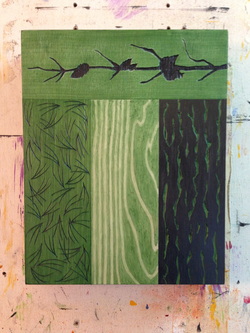 Wayne Thiebaud-"Cloud Ridge"-12.1 in. x 9.75 in. Wayne Thiebaud-"Cloud Ridge"-12.1 in. x 9.75 in. Yesterday I had the privilege of visiting the Paul Thiebaud Gallery (http://www.paulthiebaudgallery.com/) and seeing an exhibit of Wayne Thiebaud's paintings called "Memory Mountains." It was the last day of this wonderful show. There were over 40 images spanning fifty years of his career, all thematically connected by his interest in mountain landscapes. The painting pictured here, "Cloud Ridge", is an oil on canvas painted in 1967, and was on loan from a private collection. It is representative of this body of work in several ways: Thiebaud's engagement with the tactility of oil paint, his very personal palette of fluorescent-tinged color, and his strong sense of whimsy. In this painting, the trees and structures threaten to slide off of the vertiginous mountaintop. They are halted only by a large cloud, hovering like a comic exclamation point in the sky, commanding them to stop. The sun shines from the left, out of the picture plane, and highlights the edges of everything, casting three dark shadows on the side of the mountain.This is a picture that shows Thiebaud at the beginning of this series, and he stays strong and inventive throughout its long span. Very few painters are still painting when they are 93 years of age, and fewer yet are improving as they go. Thiebaud, in this regard, is like Hokusai (http://en.wikipedia.org/wiki/Hokusai), the great Japanese painter and printmaker who described himself as the "old man mad about art". Each were living for a very long time, had a great sense of humor, and were artistic masters completely committed to their craft.
1 Comment
 The photo at the left, taken with a camera phone in my studio, shows my process for arriving at the leaf images on the left side of the panel. The piece is called "Sycamore", and the leaves in the right side of the photo were collected from the grounds of Huntington Park on Nob Hill, in my hometown of San Francisco. I taped those leaves onto a piece of mat board, and then carefully drew them on the panel. This enabled me to do the composition ahead of time, and allowed me to draw directly from life, which I really enjoy. This also spared me having to draw them first on tracing paper, and then transfer them to the wood, as you see in earlier blog postings. Once the drawing was done, I carved out the area inside the drawing, using hand gouges and chisels. The next step after this is to paint the carved area with a warm Burnt Sienna acrylic color, and to finalize the patterns and shapes on the remaining parts of the panel. Using an earth tone for creating the positive shape of the leaves is a departure for me, as I usually use black and graphite. The finished piece should look really sharp!  Carved Monterey Pine II - 10 in. x 8 in. Carved Monterey Pine II - 10 in. x 8 in. In my last blog post, I mentioned a commission that I was working on for a patron from Switzerland. I am pleased to say that I finished it, and then mailed it via the US Postal Service. There is always a moment of trepidation when I ship my paintings. Even though I pack them very carefully, I worry that careless handling or some other disaster may befall them. However, the package arrived in only a few days, to our mutual delight. My patron emailed me that "These will bring some more color in my office, and a piece of California's nature as well." Kind words indeed, and it is very gratifying to have four of my carved paintings, one of which you see here, gracing a wall in Zurich. |
Bob ArmstrongI am a San Francisco artist who enjoys making art and visiting art exhibits. Archives
January 2017
|
 RSS Feed
RSS Feed